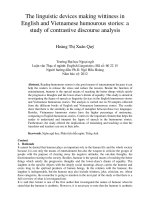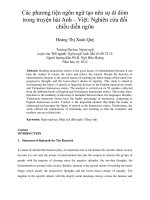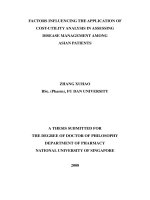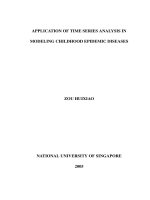Ethnography of communication conversation analysis
Bạn đang xem bản rút gọn của tài liệu. Xem và tải ngay bản đầy đủ của tài liệu tại đây (194.54 KB, 34 trang )
Ethnography of communication &
conversation analysis
Group 14:
Lê Ngọc Hân (k18A)
Nguyễn Thị Anh Thoa (k18C)
Bùi Thị Oanh (k18C)
Nguyễn Thị Tâm (k18C)
1. Ethnography of communication
Introduction
Definition
Sample analysis
Features of EC
1.1. Introduction
• The EC was developed by Hymes in a
series of papers written in the 1960s
and 1970s
• The ethnography of communication
(EC): An approach to discourse based in
anthropology and linguistics. The EC
builds a single integrated framework in
which communication has a central role
in both anthropological and linguistic
studies.
• Not only does it focus on a wider range
of communicative behaviors than other
approaches, but built into its theory and
methodology is an intentional openness
to discovery of the variety of forms and
functions available for communication.
1.2. definition
• An Ethnographic approach to discourse seeks to
discover and analyze the structures and functions
of communicating that organize the use of
language in speech situations, events and acts.
• Knowledge of these structures and functions is
part of our communicative competence: What we
say and do has meaning only within a framework
of cultural knowledge.
(Schiffrin,1994)
1.2. definition
“The EC is an approach that seek to open new
analytical possibilities (by finding new kinds of
data and asking new questions) to propose new
theories.”
• It seeks to do so by analyzing patterns of
communication as part of cultural knowledge and
behavior.
• This entails a recognition of both the diversity of
communicative possibilities and practices (i.e.
cultural relativity) and the fact that such
practices are an integrated part of what we know
and do as members of a particular culture (i.e. a
holistic view of human beliefs and actions).
(Dell Hymes:1974)
Elements of EC
Whether and to what degree something
grammatical (linguistic competence)
Whether and to what degree something
appropriate (social appropriateness)
Whether and to what degree something
feasible (psycholinguistic limitations)
Whether and to what degree something
done (observing actual language use).
is
is
is
is
Classification of Speech
Communication
• Speech situations, such as ceremonies, evening out,
sport evens, bus trips… they are not purely
communicative but provide a wider context for
speaking.
• Speech events are activities which are par excellence
communicative and governed by rules of speaking, e.g.,
conversations, lectures, political debates, ritual insults,
and so on.
• Speech acts are the smallest units of the set, e.g.
orders, jokes, greetings, summonses, compliments, etc.;
a speech act may involve more than one move from only
one person, e.g., greetings usually involve a sequence
of two “moves”.
Components of Speech events
• Hymes proposed a methodology by which to
discover “what counts” as communicative
events.
• The methodology is based on the distinction
between “emic” and “etic”.
• The classificatory grid that Hymes (1972)
proposed is known as the SPEAKING grid: each
letter is an abbreviation for a different possible
component of communication
SPEAKING GRID
GRID (HYMES:
(HYMES,1972)
SPEAKING
1972)
S (Setting)
Physical circumstances, subjective definition of an
occasion
P (Participants)
Speaker/addressee/audience/sender/hearer/receiver/ad
dressor
E (Ends)
Purposes and goals, outcomes
A (Act
sequence)
Message form and content
K (key)
Tone, manner
I
(instrumentaliti
es)
channel (verbal, nonverbal, physical), forms of speech
drawn from community repertoire
N (Norms of
interaction and
interpretation)
Specific proprieties attached to speaking interpretation
of norms within cultural belief system
G (genre)
Textual categories; the kind of speech acts or events
S.P.E.A.K.I.N.G. Grid
• Ex: On the way to classroom,
I see Mr Hoa:
• Student: Good morning Mr
Hoa. How are you (smiled
and said)?
- Teacher: Good morning, I am
fine, thanks, and you?
S.P.E.A.K.I.N.G. Grid
2 Participants
On the way to classroom
Student and teacher (Mr Hoa and
Trang)
3 Ends
Greeting
4 Act sequence
Greeting
Response
5 Key
6 Instrumentalities
Friendly manner
Verbal and nonverbal (smile)
7 Norms of
interaction
Interaction is based on greeting demand; the
need for a response
8 Genres
conversation
1 Scene-setting
SPEAKING GRID (HYMES: 1972)
• The SPEAKING grid can be used to discover a
local (i.e. culturally relative) taxonomy of
communicative units that are in some
recognizable way bounded or integral
• The largest unit is speech situation: the social
occasion in which speech may occur.
• The next unit is the speech event: activities, or
aspects of activities, that are directly governed
by rules or norms of the use of speech
• The smallest unit is the speech act (e.g.
commands, greetings, jokes)
1.3. Sample analysis
“A party is a speech situation; a
conversation during the party is a
speech event; a joke within the
conversation is a speech act”
(Hymes
1972)
1.4. Features of EC
• Structure of speech (act, event) as ways of speaking
• Analysis of use prior to analysis of code;
organization of use discloses additional features and
relations;
shows
code
and
use
in
integral
(dialectical) relation
• Gamut of stylistic or social functions
• Elements
and
structures
as
ethnographically
appropriate
• Functional (adaptive) differentiation of languages,
varieties, styles; these being existentially (actually)
not necessarily equivalent
• Speech community as matrix of code-repertoires, or
speech styles (“organization of diversity”)
• Fundamental concepts taken as problematic and to
be investigated.
Conversation Analysis
1
Definition
2
Features of CA
3
Basic concepts
1. Definition
Inspired by ethnomethodology (e.g. Herold
Gafinkel and Erving Goffman), Conversation
analysis (CA) was developed in the late 1960s
and early 1970s principally by the sociologist
Harvey Sacks and his close associates
Emanuel Schegloff and Gail Jefferson.
CA may be seen as a sub-field of Discourse
Analysis.
• CA is the study of talk in interaction (both
verbal and non-verbal in situations of
everyday life). CA generally attempts to
describe the orderliness, structure and
sequential patterns of interaction, whether
institutional (in school, a doctor's surgery,
court or elsewhere) or in casual
conversation.
• CA has been pioneered by a break-way group
of sociologists, often known as
ethnomethodologists.
• The term “Conversational analysis”(CA) has
been used to described the work that is
informed by a broad range of disciplinary
perspectives, including pragmatics, speech act
theory, interactional sociolinguistics,
ethnomethodology, the ethnography of
communication, variation analysis,
communication theory and social psychology.
(Markee,
2000)
2. Four Features of CA
1. CA is concerned with naturally occurring
data of everyday interaction.
- It uses recordings, and the transcriptions
made of them, of naturally occurring
interactions.
- They reject the use of data obtained
through formal experiments, interviews and
other forms of elicitation.
2. Four Features of CA
2. CA uses highly detailed and revealing
transcriptions of recorded voice (or
video) data that can allow deeper
analyses of how people interact.
The process of transcribing is an
important part of the discovery process,
and involves repeatedly listening to the
recording. Transcribing is undertaken
with an open mind about what might be
there, a process called unmotivated
looking.
2. Four Features of CA
3. CA is data driven and relies for its claims
on the evidence available in the data itself,
on what the participants themselves say
and do, and just how and when they do so
as the interaction develops.
2. Four Features of CA
4. CA examines what people say and do in
context, seeing how these actions occur in
sequence relative to one another, rather
than isolating actions from their contexts of
occurrence.
3. Basic concepts
3.1. Turn-taking
3.2. Adjacency pair
3.3. Transition Relevance Places
3.4. Pre-sequences
3.1. Turn-taking
The set of practices by which a conversation is
done in and through turns.
Turn-taking is one of the fundamental
organizations of conversation in which:
–
–
–
–
–
–
the speaker-change occurs,
mostly, one speaker talks at a time,
the transition from one turn to the next is without gap or overlap,
the turn order and size is not fixed,
the length and topic of contribution is not specified in advance,
the current speaker may select another speaker or parties may
self-select in starting to talk,
• According to CA, the turn-taking system
consists of two components: the turn
constructional component and the turn
allocational component.









